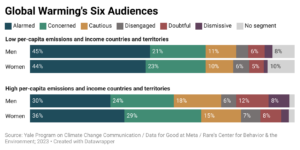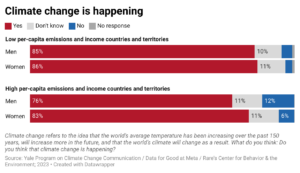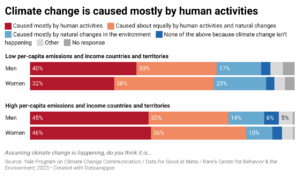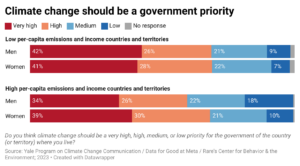Climate Note · Aug 13, 2024
International Public Opinion on Climate Change: Differences by Gender and Income/Emission Levels
By Marija Verner, Jennifer Marlon, Jennifer Carman, Seth Rosenthal, Matthew Ballew, Anthony Leiserowitz, Emily Wood, Erik Thulin, Natalia Ordaz Reynoso and Nicole Buttermore
Filed under: Audiences and Beliefs & Attitudes

Climate change affects everyone, but not equally. Women, especially in poorer countries, face disproportionate risks and challenges from extreme weather events and resource shortages. For instance, they face increased household burdens and a higher likelihood of gender-based violence during climate-related disasters. Research also finds that women are generally more concerned than men about climate change, particularly in wealthier countries.
In August and September 2023, the Yale Program on Climate Change Communication (YPCCC) conducted an international survey in collaboration with Data for Good at Meta and Rare’s Center for Behavior and the Environment to examine public climate change knowledge, attitudes, policy preferences, and behavior among Facebook users in nearly 200 countries and territories worldwide.
In the following analysis, we explore gender differences in climate change knowledge, beliefs, risk perceptions, and policy attitudes and examine how they depend on per-capita income and carbon dioxide (CO2) emission levels (see Methods). Notably, some countries with high overall emissions – such as India – have lower per-capita emissions due to large population sizes. Thirty-seven countries and territories were classified as high emissions and income, and 150 countries and territories were classified as low emissions and income.
Global Warming’s Six Audiences
Prior research in the United States by YPCCC and the George Mason University Center for Climate Change Communication has found that Americans can be categorized into six distinct groups – Alarmed, Concerned, Cautious, Disengaged, Doubtful, and Dismissive – based on their beliefs and attitudes about climate change (Global Warming’s Six Americas).
The Alarmed are convinced climate change is happening, human-caused, and an urgent threat, and strongly support climate policies. The Concerned think human-caused climate change is happening and is a serious threat, and support climate policies. However, they tend to believe that climate impacts are still distant in time and space, thus the issue remains a lower priority. The Cautious have not yet made up their minds: Is climate change happening? Is it human-caused? Is it serious? The Disengaged know little to nothing about climate change and rarely if ever hear about it. The Doubtful do not think climate change is happening or believe it is just a natural cycle. And the Dismissive are convinced climate change is not happening, human-caused, or a threat, and oppose most climate policies.
We find that in low income/emission countries and territories, a substantial proportion of men (45%) and women (44%) are Alarmed. This contrasts with high income/emission countries and territories where women (36%) are more Alarmed than men (30%). In high income/emission countries and territories, women (11%) are also much less likely to be Doubtful or Dismissive than men (20%).
Knowledge, beliefs, and policy attitudes
Self-reported knowledge about climate change differs by gender and even more by income/emission level. In low per-capita income/emission countries and territories, small percentages of men (13%) and women (9%) say they know “a lot” about climate change, and an additional 30% of men and 33% of women say they know “a moderate amount” about it. By contrast, in high per-capita emissions and income countries and territories 22% of men and 16% of women say they know “a lot” about climate change, and an additional 40% of men and 43% of women say they know “a moderate amount” about it.
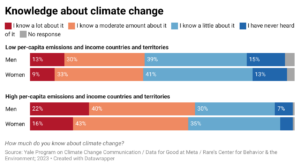
After reading a short description explaining what climate change is, a large majority of men (85%) and women (86%) in low per-capita income/emission countries and territories say climate change is happening. In high per-capita income/emission countries and territories, percentages are slightly lower – 76% of men and 83% of women. Higher percentages of respondents say climate change is not happening in high income/emission countries and territories across both genders, suggesting a relationship between emission levels and basic beliefs about climate change.
While belief that climate change is happening is generally high, fewer respondents globally understand that it is human-caused. In low per-capita income/emission countries and territories, 40% of men and 32% of women think that climate change is caused mostly by human activities. By contrast, in high per-capita income/emission countries and territories, higher percentages of both men (45%) and women (46%) think so. Notably, larger proportions of respondents from low income/emission countries and territories incorrectly attribute climate change primarily to natural changes.
42% of men and 41% of women in low per-capita income/emission countries and territories say climate change should be a “very high” priority for the government where they live, as do 39% of women in high per-capita income/emission countries and territories. By comparison, fewer men in high income/emission countries and territories think so (34%).
Overall, we find substantial differences in climate change awareness, knowledge, and support for government action between genders and across countries and territories with varying income and emission levels. There is a substantial gender gap in the Six Audiences in high-income/emission countries and territories (where women are more Alarmed or Concerned than men), but not in low-income/emission countries and territories. Many people (men and women), especially in lower-income and emission countries still know little to nothing about climate change. However, once given a short description of climate change, large majorities in all countries and territories say it is happening. But many people also do not yet understand that climate change is human-caused, with different kinds of gender gaps in low-income/emission vs. high-income/emission countries and territories. Finally, we find a substantial gender gap in public support for government action in high-income/emission countries and territories, but not in low-income/emission countries and territories.
Methods
The data in this analysis are based on a survey of 139,136 Facebook monthly active users, aged 18 and older. The survey was conducted from August 3 – September 3, 2023. Sampled Facebook users received an invitation to answer a short survey at the top of their Facebook News Feed and had the option to click the invitation to complete the survey on the Facebook platform.
The groupings of countries and territories based on per-capita emissions and income are based on (1) being above or below global average per-capita emissions (4.4 tons CO2e) and (2) having GNI per-capita that is above or below the World Bank’s criterion for a classification of “high income” (i.e., less than $12,535 USD). The complete list of countries and territories that are classified as high-emissions/income is provided here, and the complete list of countries and territories that are classified as low-income/emissions is provided here.
Audience segmentation is based on the Six Americas Super Short Survey (SASSY), a four-item online questionnaire that allows respondents to identify which segment they belong to (Chryst et al., 2018). Only respondents who answered all four questions were assigned a segment: if they skipped any of the four questions, they were assigned to the “no segment” group.
It should be noted that we have previously reported tailored audience segmentations for a number of countries which identified different numbers of segments (e.g., Global Warming’s Four Indias and Climate Change’s Four Irelands). However, these studies were based on in-depth, nationally representative surveys using different interviewing and segmentation methodologies.
